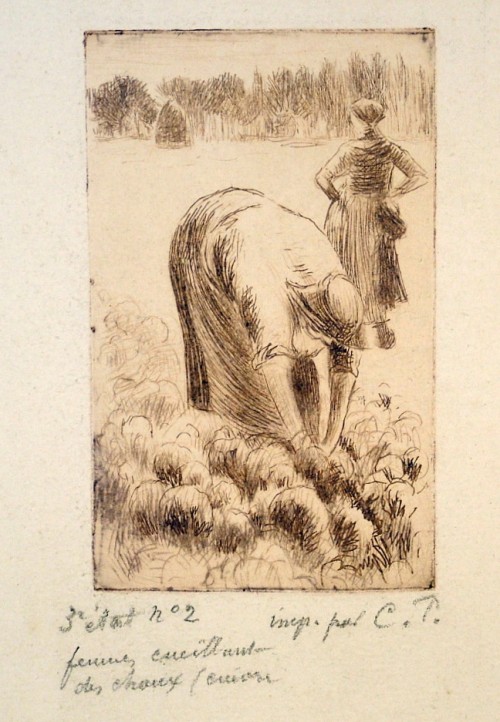Femme Cuellant des Choux (Woman Picking Cabbage)

Camille Pissarro (1830-1903), Femme Cuellant des Choux (Woman Picking Cabbage), etching, 1888. Signed, titled and inscribed by the artist (lower right: “Imp. par C.P.”; lower left: “3’etat No. 2, femme cueillant des choux/cuivre”). Reference: Delteil 77, third state (of 7). In very good condition, with wide margins (barely discernible mat stain in margins), 3 15/16 x 2 1/2, the sheet 9 1/4 x 6 inches.
A fine, delicately printed impression of this rare print, printed in a light brownish/red ink, with a subtle layer of plate tone overall, on a laid paper.
Eight impressions of this state were pulled (by Pissarro himself), each annotated 3rd etat and numbered. There were only one or two impressions pulled in each of the prior or subsequent states. After this, the third state, Pissarro darkened the composition considerably. (There were also 24 impressions pulled posthumously.)
The cabbages toward the bottom of this impression appear to be printed twice, on a greyish ground, and then defined with careful etching lines (see detail below). Here Pissarro has used the technique he and Degas developed when working together in the early 1880’s, which has been called “maniere grise” (gray manner). According to Pissarro scholar Barbara S. Shapiro (Camille Pissarro, The Impressionist Printmaker), “a pencil-shaped emery stone rubbed on the plate simulated very fine-grained aquatint that reads as a gray tonality.” The technique gives the impression that the artist has either created the print with two plates, or perhaps worked over the paper somehow with a pencil or wash by hand before pulling the impression. But although the plate has in fact been worked over carefully using different techniques, the print is made in a single pull through the press. Pissarro (and Degas) wanted to produce various printmaking effects through the print process itself, not by inking the plate by hand (a la Whistler).
As Shapiro notes: “The prints of these brief years are triumphs of printmaking, characterized by shimmering surfaces that show varying degrees of light. Yet the unusual and seemingly spontaneous effects were the result of complex procedures.”

Detail